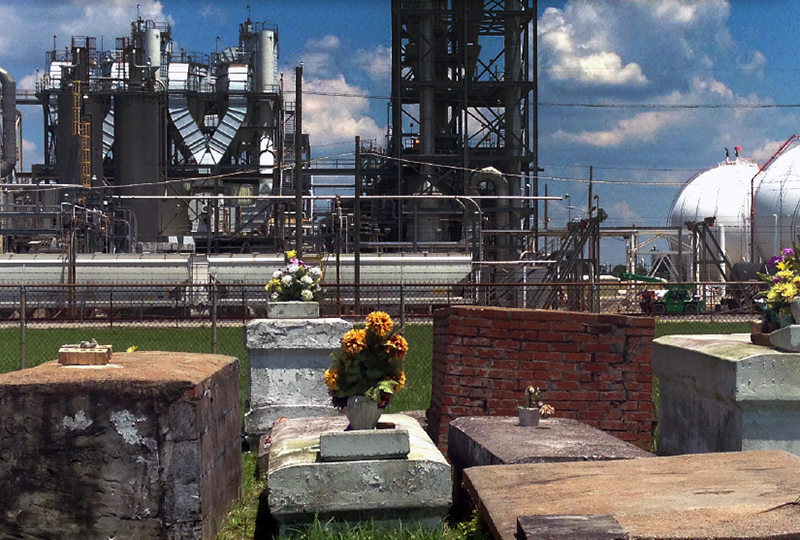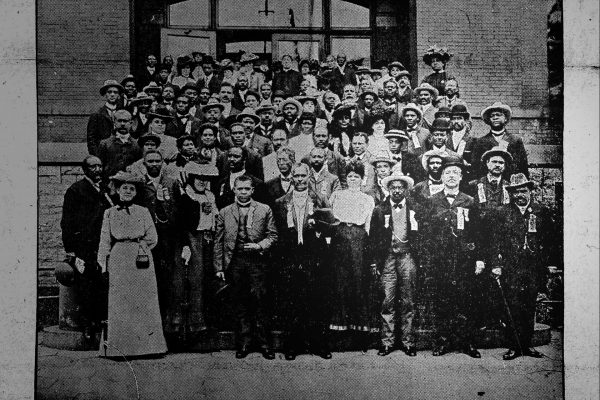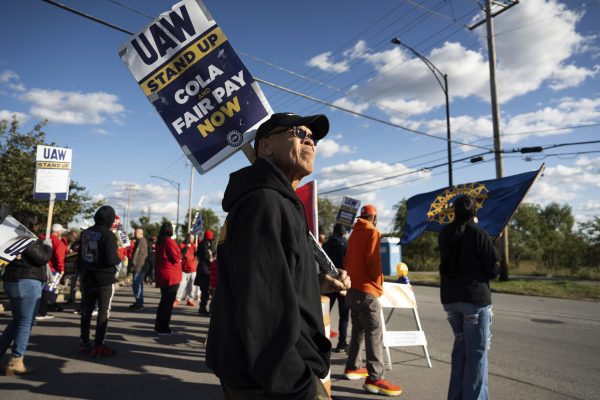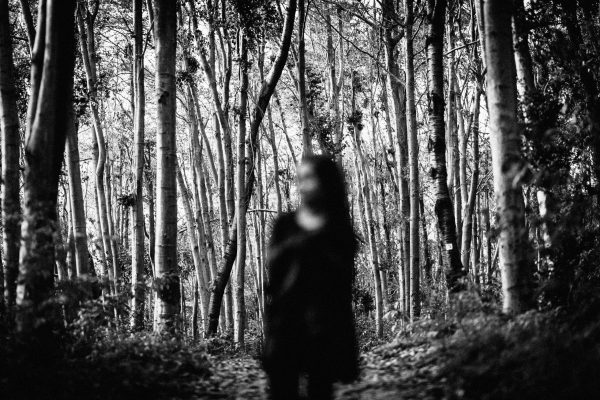On June 2, 2015, I celebrated my birthday at the Iberville Parish Court in Plaquemine, Louisiana. Plaquemine is about twenty miles southwest of Baton Rouge at a sharp turn in the Mississippi River, and I had woken up early to get there on time, filing in quietly with two friends who were there to have their case heard. We took our seats, and watched as the side door opened to admit eight men in orange jumpsuits. They were chained at the feet, hands, and necks.
“Are y’all having fun yet?” the judge asked, flashing a grin at the tiny audience.
Until his retirement in 2017, Judge James J. Best of the Eighteenth Judicial District of Louisiana presided over Iberville, Pointe Coupee, and West Baton Rouge Parishes. Locally he was most known for once grabbing a young black man by the neck during a sentencing hearing and declaring that he ought to be “taken behind a shed and whipped.”
Axiall Chemical was seeking to expand its plant onto the grounds of Revilletown Cemetery, which was founded by former slaves.
There were three cases on the docket that day, and Judge Best made quick work of the first two: he denied the probation petitions of the chained men in the front row and then dismissed a police misconduct case brought by a man who had been crippled by officers during his arrest. Then it was our turn.
My friends, Janice Dickerson and Vivian Chiphe, were up against Axiall Chemical, one of the largest vinyl manufacturing facilities in North America. The company was seeking to expand its plant onto the grounds of Revilletown Cemetery, where Dickerson’s and Chiphe’s forebears, some of whom had worked the land beneath the plant as slaves, were buried. Dickerson’s and Chiphe’s families went back to the founding of Revilletown, a small settlement created in 1874. Former slaves, organized as the Mt. Zion Baptist Association, bought a parcel of land from David Reville, a white doctor from Kentucky who owned the Reville Plantation. The present-day cemetery was established on this land, since the deceased could no longer be buried in the plantation’s slave cemeteries. Revilletown’s Mt. Zion Baptist Church was built a year later in 1875, separate from the Mount Zion Baptist Association.
Why does a tiny cemetery plot matter to Axiall? The company is worth billions; it is a Leviathan in no danger of shuttering if it cannot own a half-acre parcel of grass and bones. And yet here we were, three years into the legal battle and staring down a team of six corporate lawyers fighting for a company that wanted to own Revilletown’s dead—the most recent of whom it may have had a hand in killing with its years of pollution. Why?
Answers begin to emerge when we consider the full history of Axiall. This history illustrates how an international network of factories, an entire town, and a patch of grass are conscripted into an economic, social, cultural, legal, and racial regime that spreads over land and across time. This regime must keep the people on whose ancestral grounds it squats exactly where they are—working for Axiall or living below the national poverty level. This regime needs to keep young black men in coffles across the river in St. Gabriel’s Elayn Hunt Correctional Center. It needs men such as Judge Best to maintain that order. It needs liberal politicians, comforting orators, and plenty of committees, task forces,
and hearings to listen to and report on the needs of “the people” while turning a blind eye to the polluted southeastern Louisiana skies that send far too many to early graves. Nothing can be allowed to escape—not even a parcel of grass— because then anything could, and this wealth-generated system is built to prevent the loss of capital.
READ MORE FROM THIS ISSUE… ORDER LEFT ELSEWHERE
• • •
Georgia Hardwood Lumber Company, the enterprise that would become Axiall Corporation, was founded in Augusta, Georgia, in 1927. The fledgling wholesaler owned and represented five sawmills in the South. During World War II the company grew by leaps and bounds to become, according to its self-published history, the largest supplier of lumber to the U.S. Armed Forces. By 1949 the company—now with a new name, Georgia-Pacific Plywood and Lumber Company—was listed on the New York Stock Exchange with revenues of $37 million. In 1968, the year Mt. Zion Baptist Church upgraded to a new building in Revilletown, Georgia-Pacific sales hit $1 billion.
Residents of Revilletown have described their home as “poor in substance, but rich in spirit.” But to Georgia-Pacific, Revilletown was, as journalist Justin Nobel summarizes, “of magnificent industrial value, as a ready-made port with quick access to the grain and corn fields of the Midwest, the oil and gas reserves of the Gulf Coast, and the deposits of salt that layer southern Louisiana and contain chlorine, a necessary component in the production of many fertilizers and plastics.” And so, in the mid-1970s, a thousand feet from Revilletown, Georgia-Pacific opened its first large-scale phenol/ acetone and methanol production plant. The chemicals would be used to manufacture plywood and other wood fiber and granule-based wood byproducts, notably Brawny paper towels and Coronet toilet paper. The plant provided much-needed jobs, especially as soldiers from the Vietnam War began returning home.
In 1975 Georgia-Pacific took advantage of Louisiana’s underground salt domes, formed by prehistoric inland oceans. The domes were commonly used to store oil and natural gas, but the salt extracted from the nearby domes could also be mixed with water and run through electric currents to create chlorine-based compounds, caustic soda, and hydrogen. This chlorine compound operation was so successful that Georgia-Pacific added a new plant on the same site that would vertically integrate the production of VCM (vinyl chlorine monomer) with the methanol-based manufacturing of paper pulp. These vinyl compounds, particularly PVC (polyvinyl chloride), could then be used to create pipes, window frames, siding, flooring, shower curtains, bottles, medical tubing, and myriad other products.
As the company opened more methanol plants, Revilletown residents began noticing high rates of cancer.
In 1978 Georgia-Pacific added yet another plant beside Revilletown. The existing methanol and chlorine plants produced hydrogen as a byproduct. This excess hydrogen could be used to produce ammonia, a key component in, among other things, commercially produced fertilizers. By 1980 Georgia-Pacific expanded its vinyl facility and built a fourth plant, which produced sodium chlorate for bleaching paper and creating rocket fuel. Georgia Gulf Corporation, the chloride and petrochemical product manufacturing division that was mostly based around Revilletown, split from Georgia-Pacific through a management-led buyout in 1984.
About a hundred people lived in Revilletown during this time, and they began noticing high rates of cancer. Revilletown, sadly, is not unique; tragedies such as this are familiar in what has come to be known as Cancer Alley, the slice of Louisiana along the Mississippi that is dominated by petrochemical companies located in close proximity to poor, mainly black communities. In Revilletown, evidence of exposure to vinyl chloride gas was found in lab work done on the community’s children, and several deadly explosions over the years prompted citizen mobilization against Georgia Gulf. The levels of toxic waste in the air, soil, and water were found to be in violation of Environmental Protection Agency (EPA) standards. In 1988 residents brought a class action lawsuit against Georgia Gulf, which was settled out of court, with Georgia Gulf buying out all of the lots that comprised Revilletown. All told, Revilletown residents received a little over a million dollars for their land and homes toward the construction of new ones in New Revilletown, or “Revilletown Park,” about a mile away, on the same road but nearer to the center of the town of Plaquemine. Georgia Gulf built another church, Mt. Zion Baptist Church, in Revilletown Park. Another group of families, including Dickerson’s, did not accept the housing swap, received financial settlement, and chose their own homes in the nearby town of Brusly. The municipality of Revilletown no longer exists.
By 1991 all of the families had been relocated, and the buildings of the original Revilletown were razed, but the cemetery remained, surrounded on three sides by Georgia Gulf towers that spewed smoke, toxic vapors, and sometimes flames. Revilletown’s residents operated under the belief that Georgia Gulf did not own the graveyard, that they would have perpetual access to their ancestors’ graves, and that they could continue to fill the graveyard’s empty plots. Twenty years later, however, a dispute with the now greatly enlarged Georgia Gulf would land the question of who owned Revilletown’s dead in Judge Best’s courtroom.
• • •
After the Revilletown buyout, Georgia Gulf executives took notice of a free Thanksgiving dinner sponsored annually by the Council on Aging and organized by Lester Craig, a Georgia Gulf employee and former Revilletown resident. Georgia Gulf began sponsoring the Thanksgivings, explaining in a 2002 press release:
Iberville Parish gives us so much, it only makes sense we would want to give something back during the holidays. That’s why we sponsor the Council on Aging Thanksgiving Dinner, which provides about 800 local senior citizens with a holiday meal We see how Iberville Parish residents give freely every year to make holidays better for others. So, when it comes to giving back, Georgia Gulf takes its cue from you. Because that’s what neighbors do.
It’s what good neighbors do.
Did a few thousand dollars of turkey dinner make Georgia Gulf a good neighbor to the scattered remains of Revilletown? Many residents did not think so, and refused to attend these displays of “neighborliness.”
In 1992, plants in six Lousiana towns emitted 2 billion pounds of unregulated toxic waste and known carcinogens, with black communities disproportionately impacted.
Moreover, amidst the final stages of the town’s relocation, Georgia Gulf was among several companies that argued against a proposed EPA standard that would regulate the quantity of dioxins, which cause cancer and immune collapse, in the waste material of vinyl production. In a 1991 study by the National Environmental Law Center and the Center for Public Interest Research, Georgia Gulf remained one of the top dioxin waste culprits. Georgia Gulf’s annual report to the Securities and Exchange Commission in 1993 identified fifty-eight hazardous waste disposal sites that were under investigation by the EPA. That same year, the Louisiana Advisory Committee to the U.S. Commission on Civil Rights issued a report confirming that plants in six towns, including Revilletown, emitted about 2 billion pounds of unregulated toxic waste and known carcinogens during the previous year. The report stated:
Black communities in the corridor between Baton Rouge and New Orleans are disproportionately impacted by the present state and local government system for permitting and expansion of hazardous waste and chemical facilities. These communities are most often located in rural and unincorporated areas, and residents are of low socioeconomic status with limited political influence.
The report provided encouragement for activists who were eager to demand more than just a buffer zone; they wanted to hold Georgia Gulf accountable for the damage it had done and was doing to the land and people of Iberville Parish. Organizers and activists from Louisiana, including Dickerson, traveled to Washington, D.C., to testify in a congressional hearing on environmental justice. They spoke about the buyouts and sealed settlement documents, the ever-increasing pollution, community health issues, and deadly explosions.
On February 11, 1994, President Bill Clinton issued an “Executive Order on Federal Actions to Address Environmental Justice in Minority Populations and Low-Income Populations.” It stipulated:
Each Federal agency shall analyze the environmental effects, including human health, economic, and social effects, of Federal actions, including effects on minority communities and low-income communities, when such analysis is required by the National Environmental Policy Act of 1969. . . . Mitigation measures outlined or analyzed in an environmental assessment, environmental impact statement, or record of decision, whenever feasible, should address significant and adverse environmental effects of proposed Federal actions on minority communities and low-income communities.
The executive order was deemed in strict adherence to Title VI of the Civil Rights Act of 1964. Shortly after the order was issued, the EPA released a document of actionable steps based on the executive order. Yet the toxicity in Iberville Parish continued to grow unchecked. A 1999 report and study from the Committee on Environmental Justice Institute of Medicine confirmed that Georgia Gulf was maintaining its position as a top dioxin producer.
• • •
When they next went to the cemetery, they found the gate padlocked. Axiall argued that they legally owned it.
In early 2012, when Dickerson and Chiphe went to lay flowers on their families’ graves in the Revilletown Cemetery, they were surprised to discover a burial taking place. Neither the family nor the deceased were from Revilletown, and the family told Dickerson and Chiphe that they had paid a woman from an unaffiliated church a fee of $600 for a plot in the cemetery. Dickerson and Chiphe’s organization, Mt. Zion Baptist Association, which was formed by the descendants of Revilletown’s founders, still held the original 1881 deed to the cemetery and did not charge for burials. The $600 was nowhere to be found in the Mt. Zion Baptist Association’s coffers. Shirley Oliver, the local woman to whom these $600 checks were being made out, has refused to comment publicly on the matter. Mt. Zion Baptist Association filed a petition on October 8, 2012, for “injunctive relief against the alienation, encumbrance, or destruction of any burial plots,” both to stop the unauthorized collection of money for burial and to prevent the burials of those not descended from Revilletown families.
When they next went to the cemetery, they found the gate padlocked and a sign that read, “Visiting Hours: 9:00am– 5:00pm.” Soon Georgia Gulf—now Axiall Corporation—filed its own claim on the cemetery as an intervenor in the suit. Its lawyers claimed that the corporation had exercised full ownership of the cemetery parcel since 1970, when the property was purchased for the original Georgia Gulf plant. Though the company did not have the deed, Axiall argued that it legally owned the cemetery and had granted a separate organization, Mt. Zion Baptist Church #1, access rights in a “good faith agreement.” Mt. Zion Baptist Church #1 was represented by Shirley Oliver and unaffiliated with the Mt. Zion Baptist Association.
By the time the case came before Judge Best in 2015, Georgia Gulf had acquired PPG Industries, Inc., in a $2 billion deal and renamed itself Axiall Corporation, and thus the case’s name, Mt. Zion Baptist Association v. Mt. Zion Baptist Church #1 (Intervenor: Axiall Corporation). For lead counsel, Dickerson and Chiphe hired attorney Jerome D’Aquila. D’Aquila was a veteran on the Iberville Parish court circuit. He had been practicing law long before Best became a judge, and the two had a long history of antagonism and mudslinging documented in the local papers. D’Aquila’s three-piece suit hung from his frame unevenly, suggesting the commanding presence of his earlier days.
By contrast, Axiall Corporation was represented by a team of six sharply dressed men. They set up a projector, screen, and speakers, and delivered a multimedia presentation with maps and photos, including one of the grass in the cemetery. The Axiall team had measured the length of the grass that morning to demonstrate that the Mt. Zion Baptist Association failed to maintain the
cemetery grounds. Dickerson nearly leapt out of her seat. D’Aquila cut in, “Mt. Zion Baptist Association has sent someone to mow every week, but when they arrive, the gate is locked, and Axiall takes hours to send someone to open it when you call!”
When it was our turn, the six men leaned back in their chairs, whispering to one another. D’Aquila spoke, clutching sheets of his yellow legal pad in one hand and his cane in the other. “The people buried in this cemetery were enslaved! And these are their heirs!” He waved his papers in the air. “You cannot take their ancestors!”
Judge Best ruled in favor of Mt. Zion Baptist Church #1, Intervenor: Axiall Corporation. Dickerson and Chiphe had no legal claim to the cemetery. They would need to provide Axiall two days notice to gain access to their ancestors’ graves. We exited the courtroom more quietly than we had entered.
“Do you like fish, honey?” Chiphe asked. “Come get in the car.” We drove to Dickerson’s cousin’s restaurant nearby. The menu board read:
SPECIAL
FISH
CHICKEN
Dickerson’s cousin kissed us all and made us sit down with plastic cups of iced tea. A few minutes later, she emerged with four giant pieces of fried catfish, greens, butter yeast rolls, and Jell-O for dessert. I distinctly remember wiping my greasy hands and guiltily thinking that I felt full when I should have been feeling empty.
• • •
After Judge Best’s ruling, Dickerson and Chiphe filed an appeal. On October 31, 2016, Judge Best dismissed it. They planned to appeal again, this time to the Louisiana Court of Appeals, First Circuit, in Baton Rouge.
In the meantime, relations between Axiall and Mt. Zion Baptist Association soured even more. Dickerson and Chiphe continued to call plant security and give two days’ notice for permission to spend time with their ancestors. (After the drama over the length of the grass, Axiall did not keeping up with the mowing, leaving Mt. Zion Baptist Association to again care for the property.)
Things became particularly dramatic when one of Dickerson’s relatives died. The burial was just about to begin when Axiall called the Iberville Parish Sheriff ’s office, contending that, because they were still in litigation, no one was permitted on the cemetery property. The grave had already been dug. The family members and the truck bearing their dead were escorted out of the cemetery by the sheriff.
The burial was about to begin and the grave had been dug. The family and the truck bearing their dead were escorted out of the cemetery by the sheriff.
The First Circuit eventually ruled that Axiall did not possess the cemetery. Dickerson and the Mt. Zion Baptist Association appealed again in Iberville Parish Court for access. The appeal was dismissed on the grounds that Dickerson and Chiphe had to be elected representatives by members of the association. Since then, elections were held, and Dickerson was confirmed as a representative. And so the case remains in court, with both groups taking legal action against the other. The Mt. Zion Baptist Association swears to never stop fighting.
• • •
Someday my friends and neighbors up the river will die, just as we all will. But they may die earlier and more painfully than many others. As if this fate were not bad enough, it is possible that their children will have to call a 1-800 number to schedule a visit with them in Revilletown Cemetery.
But black struggle in Louisiana lives on in more than one form, and other battles for ownership and commemoration of African and African American cemeteries are gaining momentum elsewhere. In the spring of 2018, just downriver from Revilletown in Donaldsonville, Louisiana, Shell Corporation recognized two cemeteries of enslaved Africans and African Americans on the borders of one of its large petroleum refineries. Local historians, archaeologists, and Shell administrators had been working on the project since 2013.
Also in 2018, the state of Louisiana assembled the Slavery Ancestral Burial Grounds Preservation Commission, which includes Dickerson, dedicated specifically to discussions of how best to preserve and memorialize cemeteries such as those in Donaldsonville. There is great optimism as this movement for commemoration, born of many years of unsung shared struggles around the state, begins to move into the public spotlight.
Black struggle in Louisiana lives on.
But even with the beautiful ceremonies and the erection of memorial plaques, petrochemical companies such as Shell and Axiall continue to defy EPA regulations and fund more pipelines through ancient wetlands—all while issuing press releases that reek of paternalism. They do not realize that networks of kin and comrades are stronger than metal and steam and carbon. The spirit of black resistance is irrepressible; in Louisiana, an attack on the dead is an attack on the living. All of us, up and down the river, will answer the call for support. Because that is what good neighbors do.








